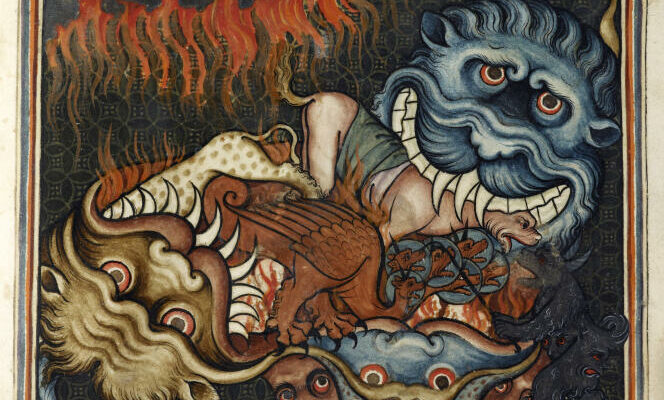Here, a copyist monk vomits frogs and warrior rabbits ride snails. There, the fruits of an apple tree are replaced by a dozen human arms and a beetroot sports a toothless smile. Here again, demons stand in a circle for a diabolical sabbath and a Satan pushes away the mouth of Hell with his hairy arms. Here, finally, a monk who appears to be wearing sunglasses is playing dice accompanied by a dog.
Spooky bestiaries, demonic representations and everyday scenes oscillating between the familiar and the absurd: representations from paintings or old manuscripts from the Middle Ages are flourishing online. These image fragments have even acquired a surprising virality thanks to specialized accounts like @weirdmedievalguys, @medievalbestiary, @medieval.psychedelia, @medieval.marginalia Or @smilingbeetroot.
Observed with our contemporary gaze, these images seem sometimes bizarre, sometimes absurd, even grotesque. ” I adore ! I look at them like a Monty Python sketch », laughs Othmane Talbi, 39, project manager in migration issues in Rabat, Morocco. They each have several tens of thousands of likes on social networks like Instagram and X. Thibault Goeringer, a 36-year-old Parisian web developer, appreciates “the diversity in the representation of the monstrous, the bizarre and the surreal: deformed, demonic animals, crude violence and representations of death which sit alongside everyday scenes that seem familiar to us, such as companionship with dogs”.
“The childhood of our current world”
This window into a distant yet familiar past also inspires artists. A tattoo artist born in eastern France and established in Montreal, Bartobello draws on the aesthetics of medieval engravings for the designs of the tattoos he creates. He notices that “this imagery is almost childish, easy to decipher for Europeans who grew up in a cultural environment made up of knights, strong castles, coats of arms and armor, but also demons and dragons. These are the markers of our childhood”.
Maria Pandiello, doctor in art history, specialist in political propaganda in the 15th centurye century and curator of the Instagram account @visions_of_manuscriptsalso uses the analogy of a return to childhood to explain the success of accounts of the curation of medieval imagery. “The Middle Ages, for us Europeans, are in some ways the childhood of our current world, an otherness both distant and familiar to which we always return to better understand ourselves. A bit like psychotherapy. »
You have 69.26% of this article left to read. The rest is reserved for subscribers.
